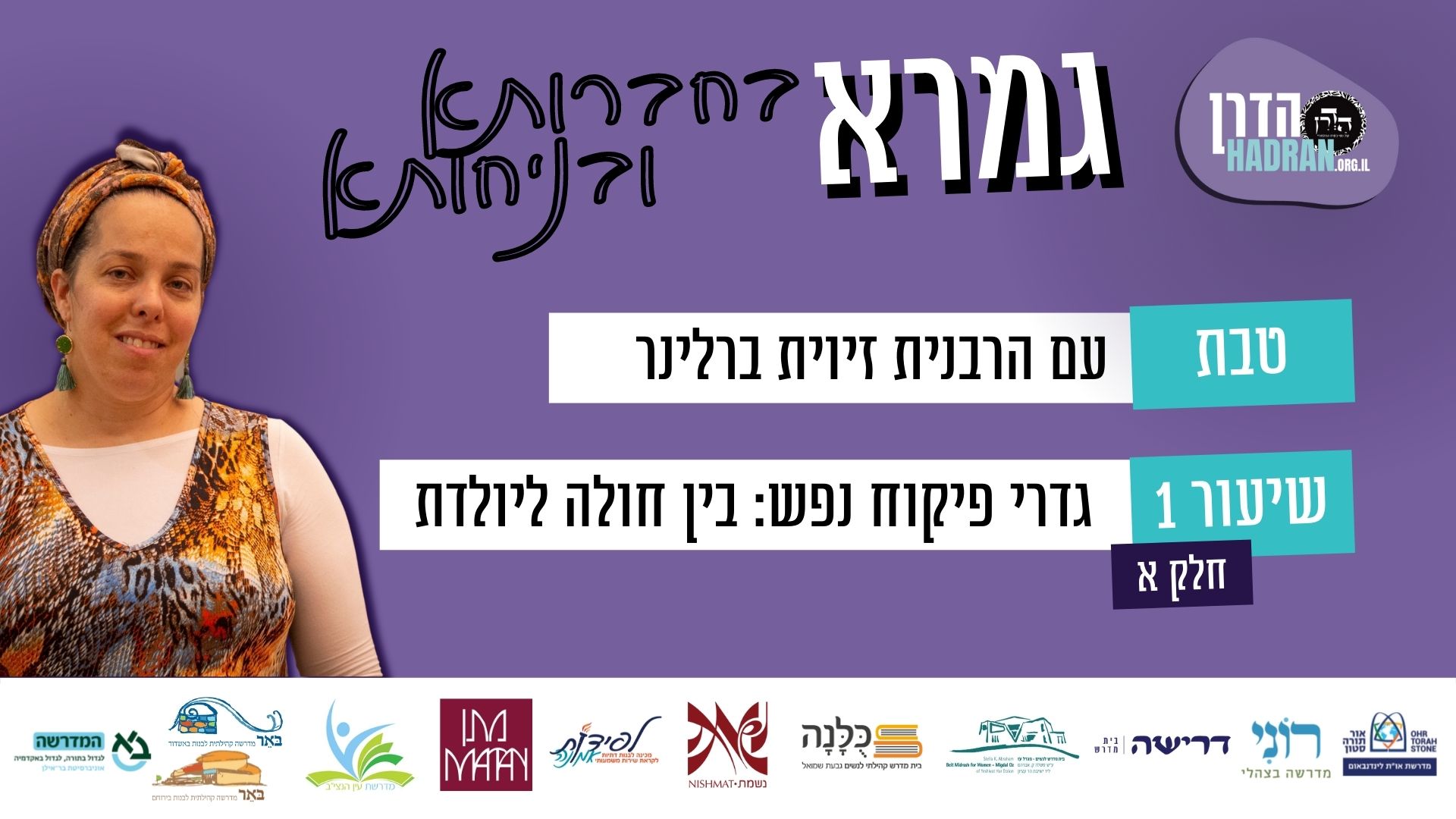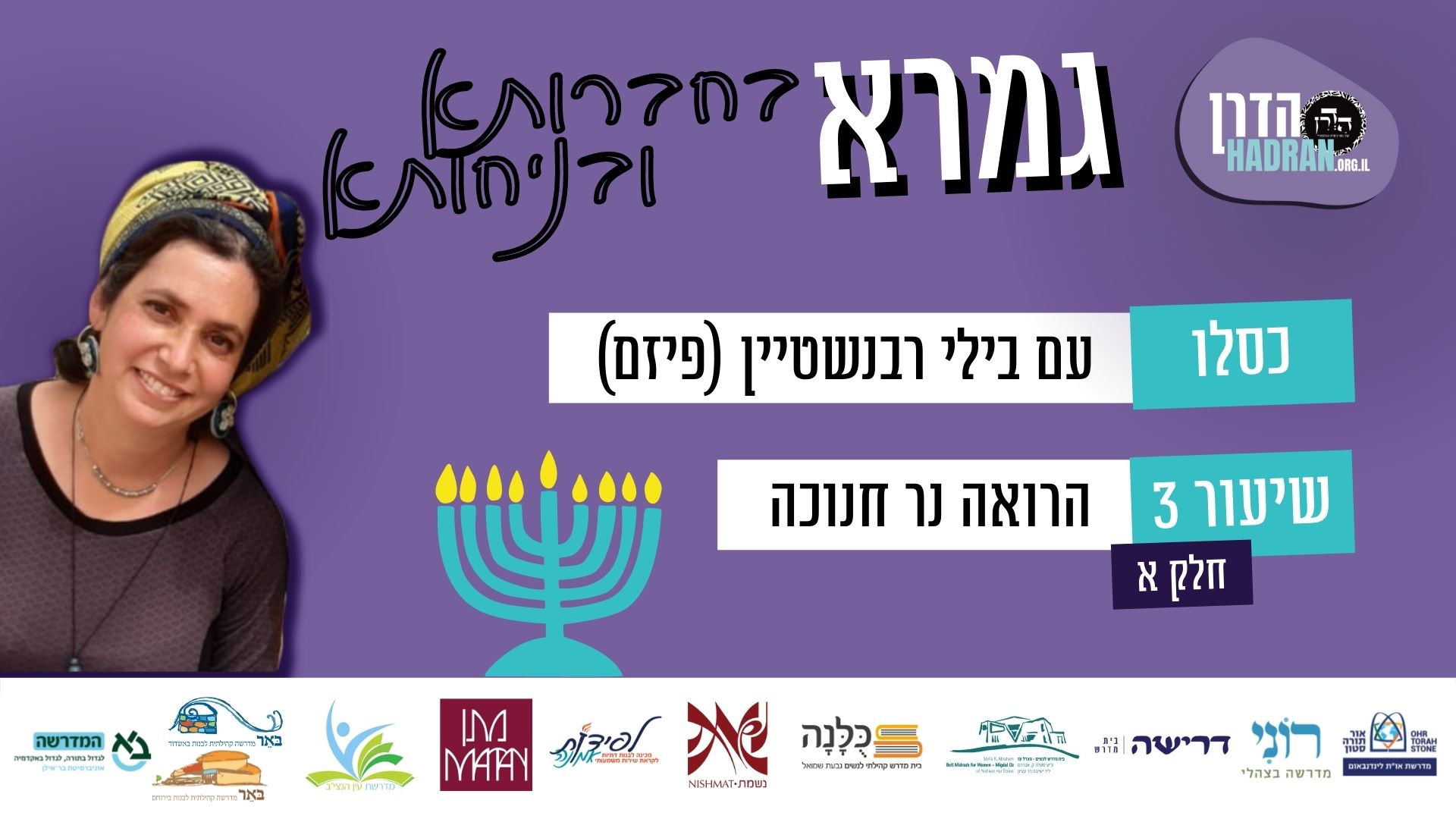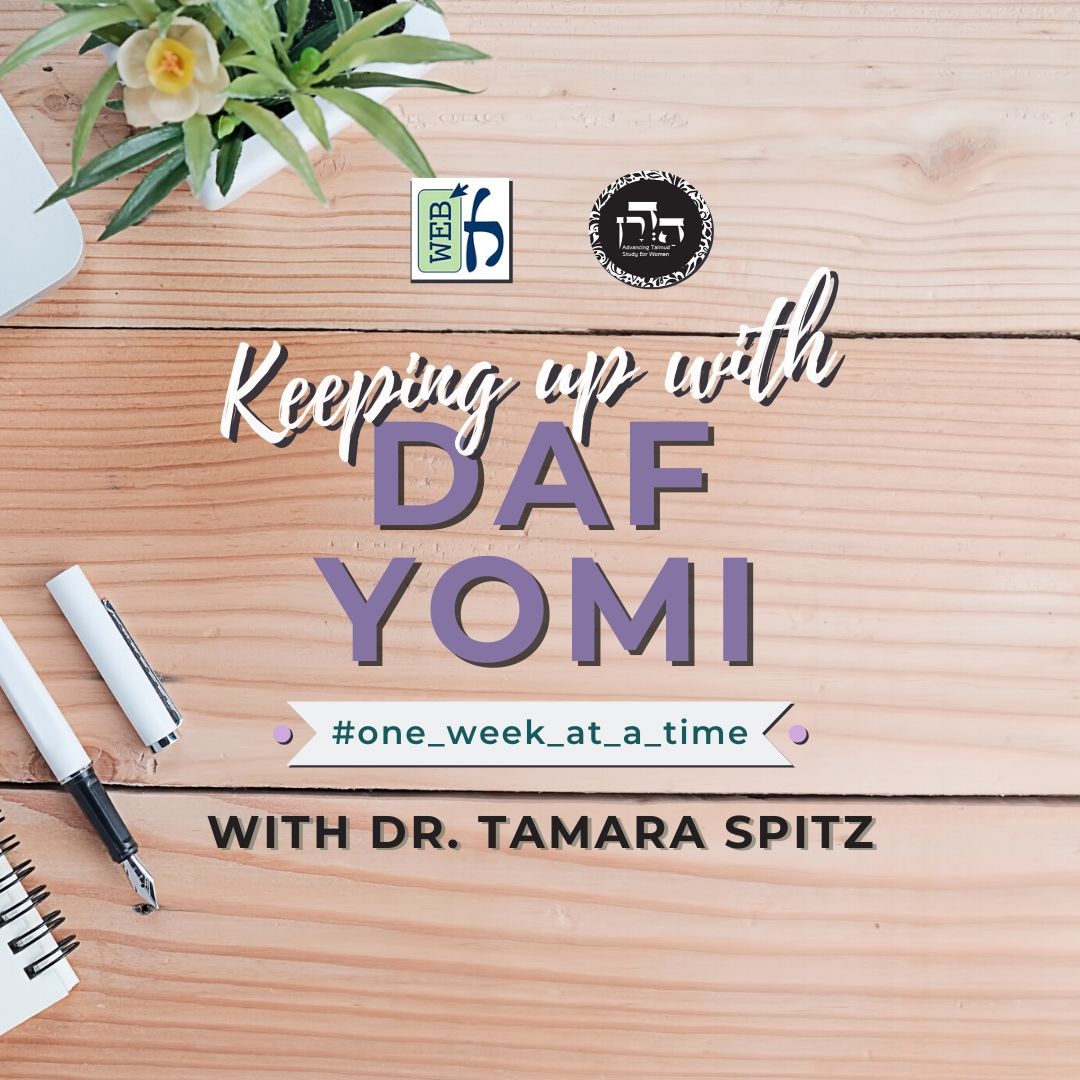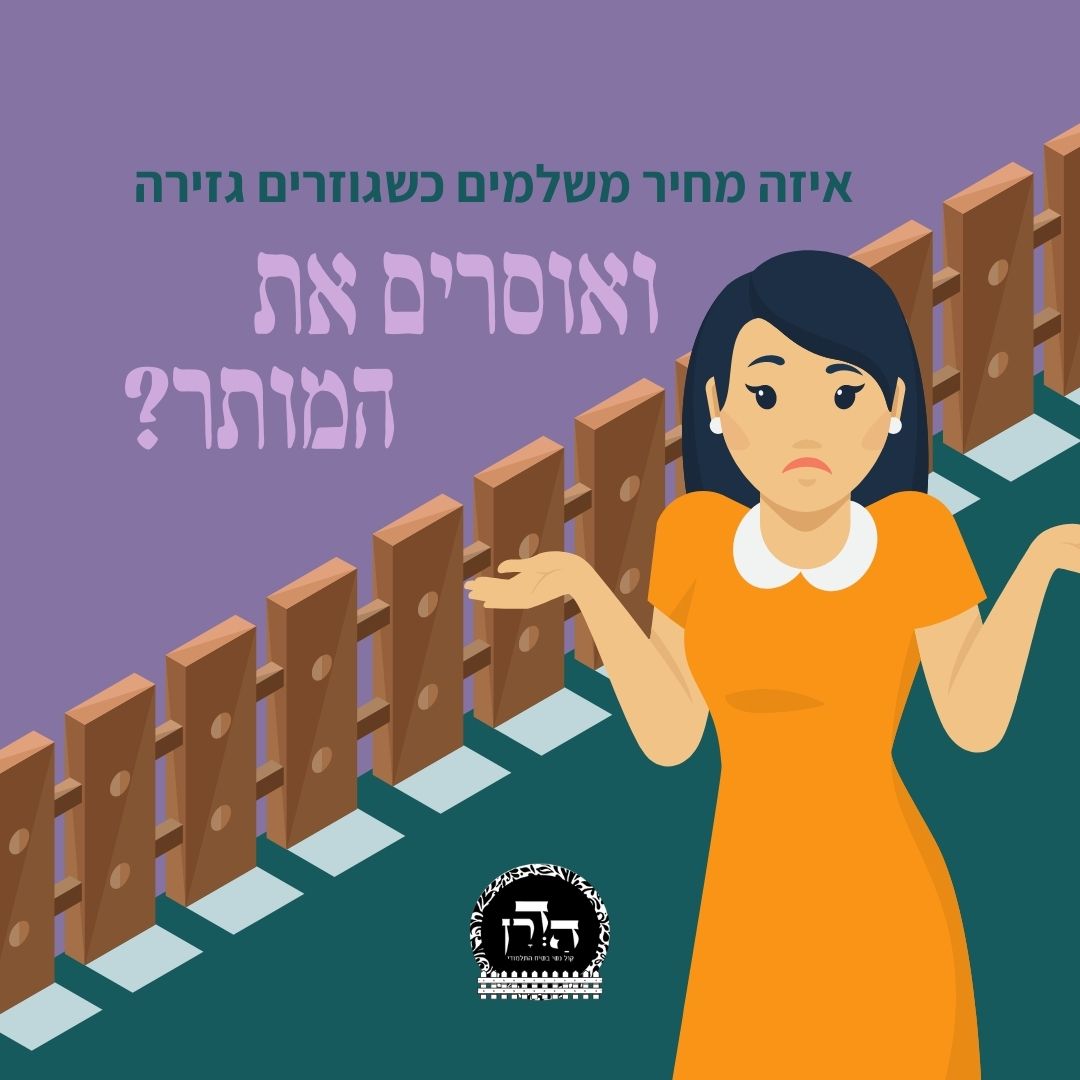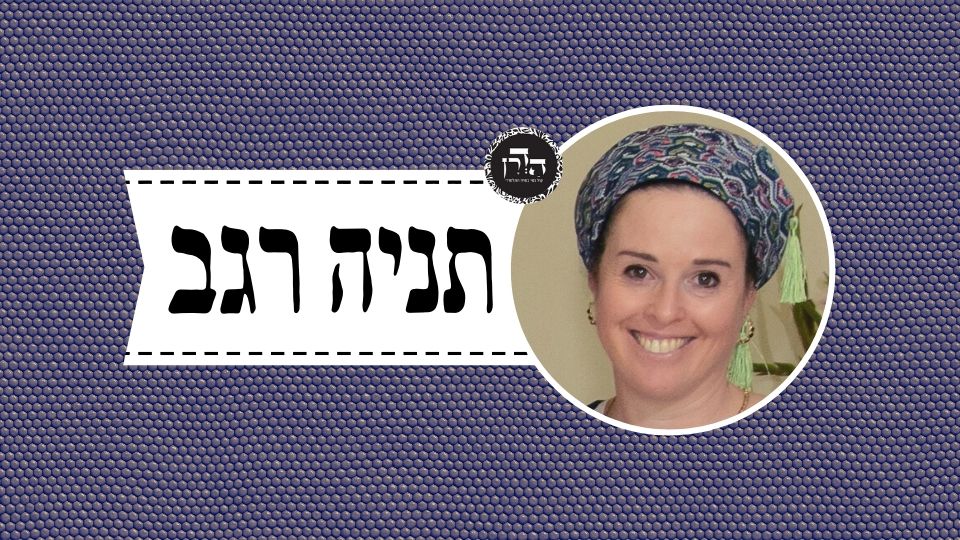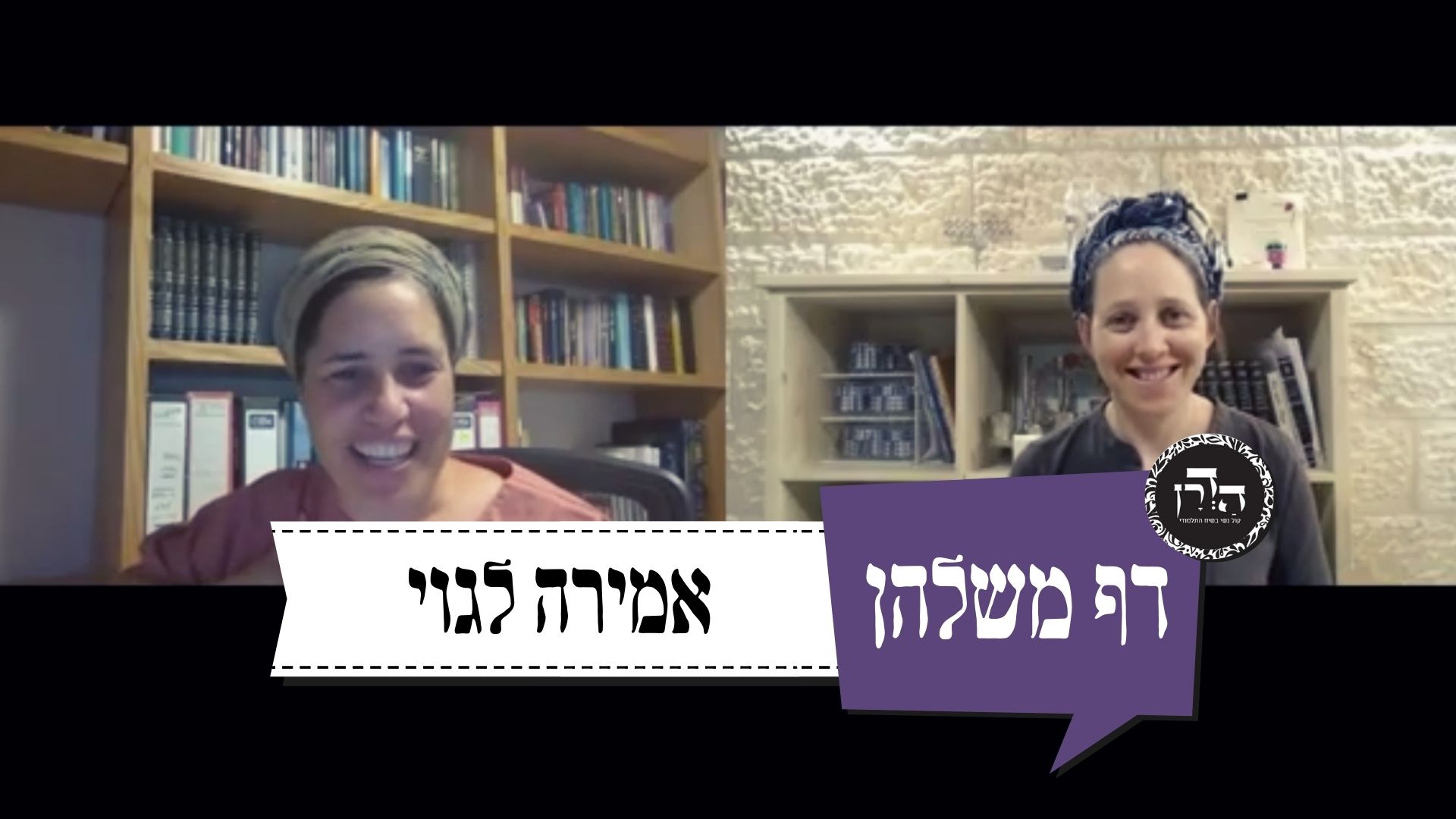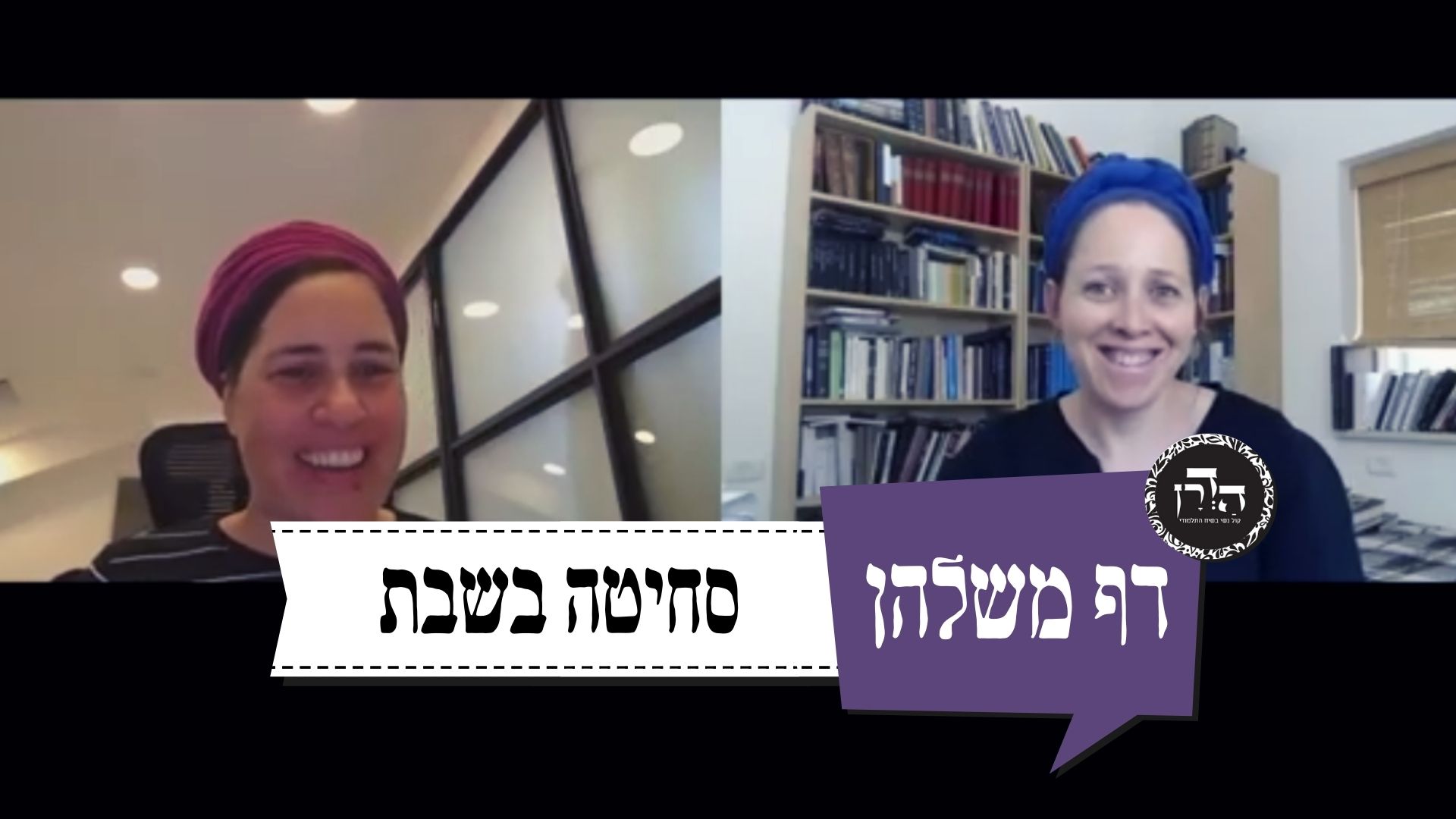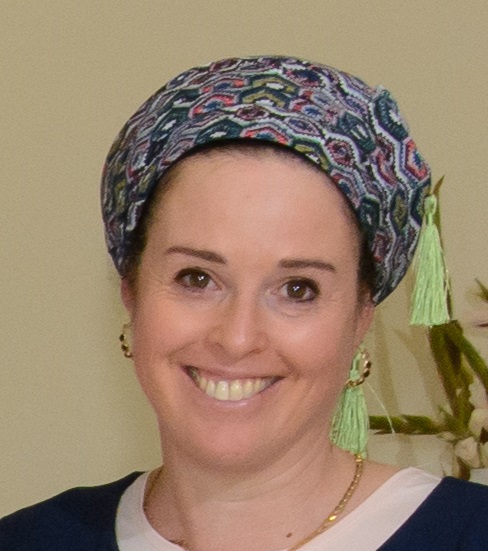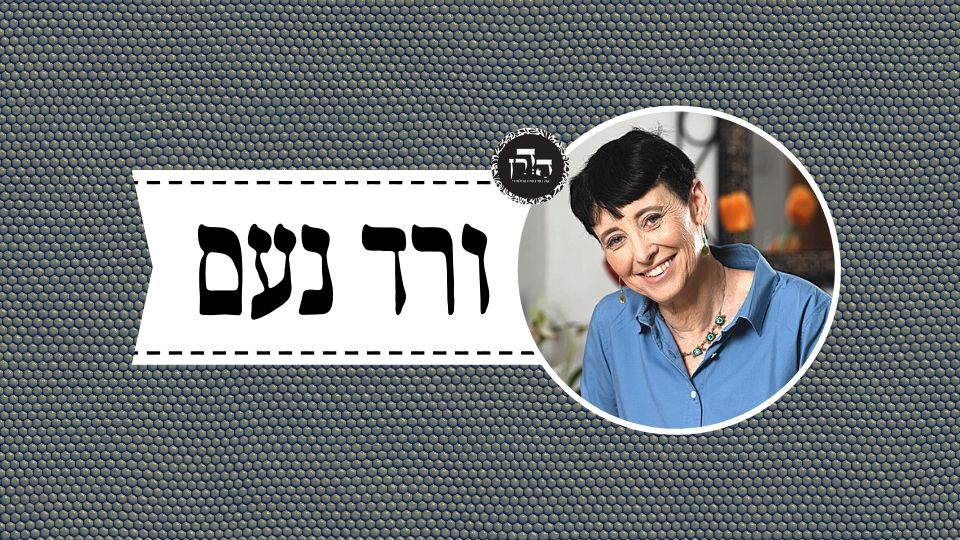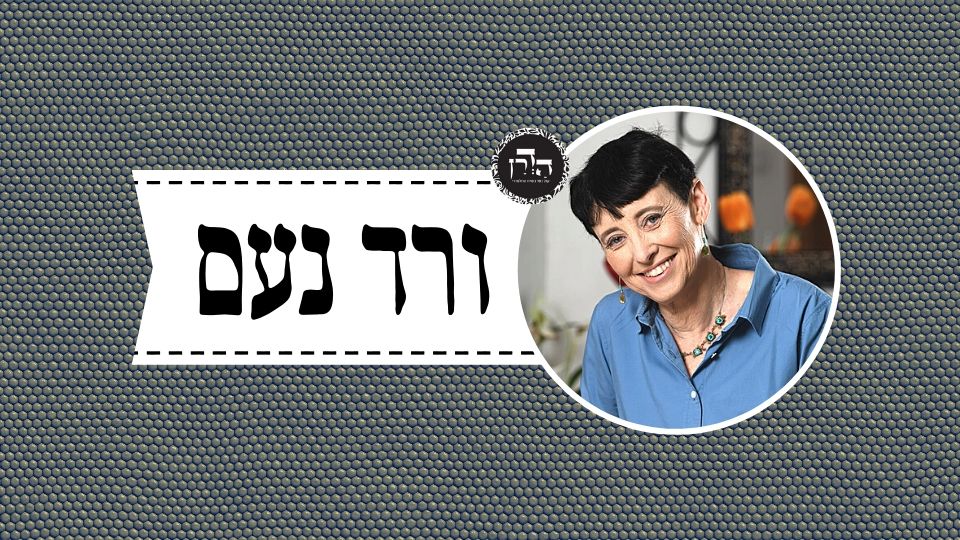אם מוציאים את העינבל מהזוג זה עדיין מקבל טומאה – למה? למה זה ראוי? הגמרא מביאה כמה פירושים ובתוכם ר’ יוחנן שאומר שאפשר לתת לתינוק לשתות ממנו. אבל ר’ יוחנן אומר במקום אחר שאם הכלי אינו ראוי לתשמישו הראשון, הרי אינו מקבל טומאה? איך פותרים את הסתירה? הגמרא עוברת על רשימת התכשיטים ומסבירה מהם, מהם חילוקי דעות לגבי חלק מהם, האם יש סוגים שונים שמותרים? האם יש תכשיטים שרק נשים חשובות לובשות ואם כן, האם אפשר להגיד בגלל שנשים אלו לא תורידו, אז מותר לצאת איתם?
הלימוד השבוע מוקדש ע”י רוברט ופאולה כהן לע”נ יוסף בן משה הכהן ז”ל. יוסף היה חזן שאהב מאוד לשיר, עבד קשה בחייו והיה מאוד מסור למשפחתו ולקהילה.
רוצה להקדיש שיעור?

כלים
הלימוד השבוע מוקדש ע”י רוברט ופאולה כהן לע”נ יוסף בן משה הכהן ז”ל. יוסף היה חזן שאהב מאוד לשיר, עבד קשה בחייו והיה מאוד מסור למשפחתו ולקהילה.
כלים
העמקה
רוצה להבין מה באמת קורה מתחת לפני השטח של הסוגיה?
שיעורים, פודקאסטים והרחבות של מיטב המורות שלנו יפתחו לך עוד זוויות וכיווני חשיבה.
חדשה בלימוד הגמרא?
זה הדף הראשון שלך? איזו התרגשות עצומה! יש לנו בדיוק את התכנים והכלים שיעזרו לך לעשות את הצעדים הראשונים ללמידה בקצב וברמה שלך, כך תוכלי להרגיש בנוח גם בתוך הסוגיות המורכבות ומאתגרות.
פסיפס הלומדות שלנו
גלי את קהילת הלומדות שלנו, מגוון נשים, רקעים וסיפורים. כולן חלק מתנועה ומסע מרגש ועוצמתי.
שבת נט
הוֹאִיל וְרָאוּי לְהַקִּישׁוֹ עַל גַּבֵּי חֶרֶס.
It is considered a vessel since a bell without a clapper is suited to strike on earthenware and produce a sound of similar quality to that produced by a clapper. If so, even when the clapper is removed, the bell may still be used for its original purpose.
אִיתְּמַר נָמֵי, אָמַר רַבִּי יוֹסֵי בְּרַבִּי חֲנִינָא: הוֹאִיל וְרָאוּי לְהַקִּישׁוֹ עַל גַּבֵּי חֶרֶס. רַבִּי יוֹחָנָן אָמַר: הוֹאִיל וְרָאוּי לְגַמֵּעַ בּוֹ מַיִם לְתִינוֹק.
It was also stated that Rabbi Yosei, son of Rabbi Ḥanina, said: It is considered a vessel, since a bell without a clapper is suited to strike on earthenware. Rabbi Yoḥanan said: It is considered a vessel, since it is suited for use to give water to a child to drink.
וְרַבִּי יוֹחָנָן לָא בָּעֵי מֵעֵין מְלָאכָה רִאשׁוֹנָה? וְהָתַנְיָא: ״וְכׇל כְּלִי אֲשֶׁר יֵשֵׁב עָלָיו וְגוֹ׳״ — יָכוֹל כָּפָה סְאָה וְיָשַׁב עָלֶיהָ, כָּפָה תַּרְקַב וְיָשַׁב עָלֶיהָ יְהֵא טָמֵא, תַּלְמוּד לוֹמַר: ״אֲשֶׁר יֵשֵׁב עָלָיו הַזָּב״ — מִי שֶׁמְיוּחָד לִישִׁיבָה, יָצָא זֶה שֶׁאוֹמְרִים לוֹ: עֲמוֹד וְנַעֲשֶׂה מְלַאכְתֵּנוּ.
And with regard to the essence of Rabbi Yoḥanan’s statement, the Gemara asks: And does Rabbi Yoḥanan not require that the vessel’s new usage must be of the same type as the original labor in order for it to retain its ritual impurity after it has undergone change? Wasn’t it taught in a baraita: “Every bed on which a zav is lying is ritually impure and every vessel on which he is sitting shall be ritually impure” (Leviticus 15:4). I might have thought, based on this verse, that if one overturned a vessel the size of a se’a and sat on it, or overturned a vessel the size of a half-se’a [tarkav] and sat on it, the vessel would become ritually impure. Therefore, the verse states: On which the zav is sitting, i.e., that which is designated for sitting, excluding that vessel with regard to which one says to the zav: Stand and we will perform our labor with the vessel. In that case, because the vessel is primarily used for purposes other than sitting, it does not become ritually impure even when the zav sits on it.
רַבִּי אֶלְעָזָר אוֹמֵר: בְּמִדְרָסוֹת אוֹמְרִים ״עֲמוֹד וְנַעֲשֶׂה מְלַאכְתֵּנוּ״, וְאֵין אוֹמְרִים בִּטְמֵא מֵת ״עֲמוֹד וְנַעֲשֶׂה מְלַאכְתֵּנוּ״. וְרַבִּי יוֹחָנָן אָמַר: אַף אוֹמֵר בִּטְמֵא מֵת ״עֲמוֹד וְנַעֲשֶׂה מְלַאכְתֵּנוּ״.
There is a dispute between the amora’im on this matter: Rabbi Elazar says: With regard to ritual impurity imparted by treading [midras], i.e., the halakhot pertaining to a zav or to a menstruating woman who sits or lies down on an object, one states the principle: Stand and we will perform our labor to maintain the purity of the vessel. However, one does not state with regard to one who is ritually impure due to a corpse: Stand and we will perform our labor to maintain the purity of the vessel. In other words, an object that became ritually impure through contact with a corpse and was subsequently broken, since it is possible to use it for some other purpose, it remains a vessel and susceptible to ritual impurity. However, Rabbi Yoḥanan said: Even with regard to one who is ritually impure due to a corpse, one states the principle: Stand and we will perform our labor to maintain the purity of the vessel. According to his opinion, a vessel that is no longer suited for its initial use, even though it serves another purpose, is considered broken. Therefore, the bell, since it is no longer suited for ringing, remains ritually pure according to Rabbi Yoḥanan’s opinion, even though it remains suited for drinking water.
אֵיפוֹךְ קַמַּיְיתָא. וּמַאי חֲזֵית דְּאָפְכַתְּ קַמַּיְיתָא? אֵיפוֹךְ בָּתְרָיְיתָא!
The Gemara answers: Reverse the opinions in the first dispute: It was not Rabbi Yoḥanan who gave that reason; it was Rabbi Yosei, son of Rabbi Ḥanina. The Gemara asks: And what did you see that led you to reverse the first? Reverse the opinions of Rabbi Yoḥanan and Rabbi Elazar in the latter dispute, and avoid a contradiction in the statements of Rabbi Yoḥanan in that way.
הָא שָׁמְעִינַן לֵיהּ לְרַבִּי יוֹחָנָן דְּבָעֵי מֵעֵין מְלָאכָה רִאשׁוֹנָה. דְּתַנְיָא: סַנְדָּל שֶׁל בְּהֵמָה שֶׁל מַתֶּכֶת טָמֵא. לְמַאי חֲזֵי? אָמַר רַב: רָאוּי לִשְׁתּוֹת בּוֹ מַיִם בַּמִּלְחָמָה. וְרַבִּי חֲנִינָא אָמַר: רָאוּי לָסוּךְ בּוֹ שֶׁמֶן בַּמִּלְחָמָה. וְרַבִּי יוֹחָנָן אָמַר: בְּשָׁעָה שֶׁבּוֹרֵחַ מִן הַקְּרָב מַנִּיחוֹ בְּרַגְלָיו וְרָץ עַל קוֹצִין וְעַל הַבַּרְקָנִים.
The Gemara answers: That is because we learned elsewhere that Rabbi Yoḥanan requires that the vessel’s new use will be of the same type as the original labor. His opinion here is consistent with his opinion there. As it was taught in a baraita: The shoe of an animal, if it is made of metal, can become ritually impure. The Gemara asks: For what use by people is it suited? Vessels designated for animal use do not become ritually impure unless they have some use for people. Rav said: It is suited for use as a vessel from which one could drink water in war when there are no other available vessels. And Rabbi Ḥanina said: It is suited for use as a vessel from which one could smear oil on his body during a war. And Rabbi Yoḥanan said: When he flees from the battlefield he places it on his foot and runs over thorns and the thistles. Apparently, the only use for the shoe of an animal that would render it capable of becoming ritually impure when used by a person is use of the same type as the original labor.
מַאי בֵּין רַב לְרַבִּי חֲנִינָא? אִיכָּא בֵּינַיְיהוּ דִּמְאִיס.
The Gemara asks parenthetically: What is the practical difference between the explanation of Rav and that of Rabbi Ḥanina? The Gemara answers: There is a practical difference between them in a case where the sandal is repulsive and dirty. In Rav’s opinion, since one would not drink water from it, it cannot become ritually impure. According to Rabbi Ḥanina, since one could still use it to spread oil on his body, it can become ritually impure.
בֵּין רַבִּי יוֹחָנָן לְרַבִּי חֲנִינָא? אִיכָּא בֵּינַיְיהוּ דְּיַקִּיר.
What is the practical difference between the explanation of Rabbi Yoḥanan and that of Rabbi Ḥanina? There is a practical difference between them in a case where the shoe is heavy. It is suited for spreading oil; it is not suited for one to place on his foot. Therefore, it cannot become ritually impure according to Rabbi Yoḥanan.
וְלֹא בְּעִיר שֶׁל זָהָב. מַאי ״בְּעִיר שֶׁל זָהָב״? רַבָּה בַּר בַּר חָנָה אָמַר רַבִּי יוֹחָנָן: יְרוּשָׁלַיִם דְּדַהֲבָא,
We learned in the mishna: And neither may a woman go out on Shabbat to the public domain with a city of gold. The Gemara asks: What is the meaning of: With a city of gold? Rabba bar bar Ḥana said that Rabbi Yoḥanan said: Jerusalem of Gold, a gold tiara engraved with a depiction of the city of Jerusalem,
כְּדַעֲבַד לֵיהּ רַבִּי עֲקִיבָא לִדְבֵיתְהוּ.
like the one that Rabbi Akiva made for his wife.
תָּנוּ רַבָּנַן: לֹא תֵּצֵא אִשָּׁה בְּעִיר שֶׁל זָהָב, וְאִם יָצְתָה חַיֶּיבֶת חַטָּאת, דִּבְרֵי רַבִּי מֵאִיר. וַחֲכָמִים אוֹמְרִים: לֹא תֵּצֵא, וְאִם יָצְתָה — פְּטוּרָה. רַבִּי אֱלִיעֶזֶר אוֹמֵר: יוֹצְאָה אִשָּׁה בְּעִיר שֶׁל זָהָב לְכַתְּחִלָּה.
And on this subject, the Sages taught in the Tosefta: A woman may not go out into the public domain on Shabbat with a city of gold ornament. And if she went out with it into the public domain she is liable to bring a sin-offering; that is the statement of Rabbi Meir. And the Rabbis say: She may not go out with it ab initio, and if she went out she is exempt. And Rabbi Eliezer says: A woman may go out with a city of gold ornament ab initio.
בְּמַאי קָמִיפַּלְגִי? רַבִּי מֵאִיר סָבַר מַשּׂוֹי הוּא. וְרַבָּנַן סָבְרִי תַּכְשִׁיט הוּא — דִּילְמָא שָׁלְפָא וּמַחְוְיָא לֵיהּ וְאָתְיָא לְאֵתוֹיֵי. וְרַבִּי אֱלִיעֶזֶר סָבַר: מַאן דִּרְכֵּהּ לְמִיפַּק בְּעִיר שֶׁל זָהָב — אִשָּׁה חֲשׁוּבָה, וְאִשָּׁה חֲשׁוּבָה לָא שָׁלְפָא וּמַחְוְיָא.
The Gemara explains: With regard to what principle do they disagree? Rabbi Meir holds that it is considered a burden and not an ornament, and one who carries a burden into the public domain is liable to bring a sin-offering. And the Rabbis hold that it is an ornament. Why, then, did they prohibit going out into the public domain wearing it? They are concerned lest she remove it, and show it to another, and come to carry it in the public domain. And Rabbi Eliezer holds: Whose manner is it to go out with a city of gold ornament? Only an important woman, and in that case there is no concern, as an important woman does not remove ornaments and show them to others.
כְּלִילָא, רַב אָסַר וּשְׁמוּאֵל שָׁרֵי.
After discussing going out into the public domain on Shabbat with a city of gold ornament, the Gemara discusses other ornaments. There is a dispute among amora’im with regard to a kelila, which is a tiara-like ornament. Rav prohibited going out with it, and Shmuel permitted doing so.
דַּאֲנִיסְכָּא, כּוּלֵּי עָלְמָא לָא פְּלִיגִי דַּאֲסִיר. כִּי פְּלִיגִי דַּאֲרוּקְתָּא: מָר סָבַר אֲנִיסְכָּא עִקָּר, וּמָר סָבַר אֲרוּקְתָּא עִקָּר.
The Gemara sets the parameters of the disagreement: With a kelila made of metal, everyone agrees that it is prohibited to go out into the public domain. Where they disagree is in the case of a woven fabric inlaid with metal. One Sage, Rav, holds that in that type of ornament the metal is the primary element, and it is prohibited. And one Sage, Shmuel, holds that the woven fabric is the primary element, and it is consequently permitted.
רַב אָשֵׁי מַתְנֵי לְקוּלָּא: דַּאֲרוּקְתָּא דְּכוּלֵּי עָלְמָא לָא פְּלִיגִי דִּשְׁרֵי. כִּי פְּלִיגִי דַּאֲנִיסְכָּא: מָר סָבַר דִּילְמָא שָׁלְפָא וּמַחְוְיָא וְאָתֵי לְאֵתוּיֵי, וּמָר סָבַר מַאן דִּרְכֵּהּ לְמִיפַּק בִּכְלִילָא — אִשָּׁה חֲשׁוּבָה, וְאִשָּׁה חֲשׁוּבָה לָא שָׁלְפָא וּמַחְוְיָא.
Rav Ashi taught this disagreement with a lenient interpretation, as he said: With a kelila of woven fabric, everyone agrees that it is permitted to go out into the public domain. Where they disagree is in the case of a metal ornament. One Sage, Rav, holds that it is prohibited because there is concern lest she remove it, and show it to another, and come to carry it in the public domain. And one Sage, Shmuel, holds that it is permitted. Whose manner is to go out with a kelila ornament? Only an important woman; and an important woman does not remove ornaments and show them to others.
אֲמַר לֵיהּ רַב שְׁמוּאֵל בַּר בַּר חָנָה לְרַב יוֹסֵף: בְּפֵרוּשׁ אֲמַרְתְּ לַן מִשְּׁמֵיהּ דְּרַב — ״כְּלִילָא שְׁרֵי״.
On the same topic, Rav Shmuel bar bar Ḥana said to Rav Yosef who, due to illness, forgot his learning: You explicitly said to us in the name of Rav: With regard to a kelila, it is permitted to go out into the public domain on Shabbat.
אֲמַרוּ לֵיהּ לְרַב: אֲתָא גַּבְרָא רַבָּה אֲרִיכָא לִנְהַרְדְּעָא וּמִטְּלַע, וְדָרֵשׁ ״כְּלִילָא שְׁרֵי״. אֲמַר: מַאן גַּבְרָא רַבָּה אֲרִיכָא [דְּאִיטְּלַע] — לֵוִי, שְׁמַע מִינַּהּ נָח נַפְשֵׁיהּ דְּרַבִּי אַפָּס וִיתִיב רַבִּי חֲנִינָא בְּרֵישָׁא, וְלָא הֲוָה לֵיהּ אִינִישׁ לְלֵוִי לְמֵיתַב גַּבֵּיהּ, וְקָאָתֵי לְהָכָא.
The Gemara relates that one day they said to Rav: A great, tall man came to Neharde’a and he was limping. And he taught: With a kelila, it is permitted to go out into the public domain on Shabbat. Rav said: Who is a great, tall man who limps? Levi. Conclude from this that Rabbi Afes passed away and Rabbi Ḥanina is sitting at the head of the yeshiva in Eretz Yisrael in his place. And, consequently, Levi had no one before whom to sit and study and he came here. As long as Rabbi Afes headed the yeshiva, Rabbi Ḥanina would sit outside the study hall. Entering the study hall would indicate that he accepted the authority of Rabbi Afes. Rabbi Ḥanina, who was a great man, refused to do so. In deference to Rabbi Ḥanina, Levi would sit with him as a colleague outside the study hall. When Levi arrived from Eretz Yisrael, it was clear that Rabbi Afes must have died. Levi, who considered himself Rabbi Ḥanina’s equal in terms of both scholarship and age, did not want to defer to Rabbi Ḥanina’s authority and decided to go to elsewhere, to Babylonia.
וְדִילְמָא נָח נַפְשֵׁיהּ דְּרַבִּי חֲנִינָא, וְרַבִּי אַפָּס כִּדְקָאֵי קָאֵי, וְלָא הֲוָה לֵיהּ אִינִישׁ לְלֵוִי לְמֵיתַב גַּבֵּיהּ, וְקָאָתֵי לְהָכָא? אִם אִיתָא דְּרַבִּי חֲנִינָא שְׁכֵיב — לֵוִי לְרַבִּי אַפָּס מִיכָּף הֲוָה כְּיִיף לֵיהּ. וְתוּ, דְּרַבִּי חֲנִינָא לָא סַגִּי דְּלָא מָלֵיךְ, דְּכִי הֲוָה קָא נִיחָא נַפְשֵׁיהּ דְּרַבִּי אָמַר: חֲנִינָא בְּרַבִּי חָמָא יֵשֵׁב בָּרֹאשׁ. וּכְתִיב בְּהוּ בְּצַדִּיקִים: ״וְתִגְזַר אֹמֶר וְיָקׇם לָךְ וְגוֹ׳״.
The Gemara asks: How did Rav arrive at that particular conclusion? And perhaps Rabbi Ḥanina died and Rabbi Afes remained standing in his position at the head of the yeshiva as he stood previously; and Levi had no one with whom to sit outside the study hall, and that is why he came here? The Gemara answers that that could not be the case for two reasons. First, if it were so, that Rabbi Ḥanina died, Levi would have been subject to the authority of Rabbi Afes. It was only in deference to Rabbi Ḥanina that Levi did not enter the study hall. And furthermore, it could not be that Rabbi Ḥanina died and did not reign as head of the yeshiva, as when Rabbi Yehuda HaNasi died, he said in his dying testament: Ḥanina, son of Rabbi Ḥama, shall sit at the head of the yeshiva. And of the righteous it is written: “You will decree a saying and it will be established for you, and the light will shine on your ways” (Job 22:28). Since the statement that Rabbi Ḥanina will serve at the head of the yeshiva crossed the lips of a righteous person, Rabbi Yehuda HaNasi, it is inconceivable that it would not have been realized.
דְּרַשׁ לֵוִי בִּנְהַרְדְּעָא ״כְּלִילָא שְׁרֵי״. נְפוּק עֶשְׂרִין וְאַרְבַּע כְּלִילֵי מִכּוּלַּהּ נְהַרְדְּעָא. דְּרַשׁ רַבָּה בַּר אֲבוּהּ בְּמָחוֹזָא ״כְּלִילָא שְׁרֵי״, וּנְפַקוּ תַּמְנֵי סְרֵי כְּלִילֵי מֵחֲדָא מְבוֹאָה.
The Gemara returns to the subject of kelila. When Levi taught in Neharde’a that with the kelila ornament, one is permitted to go out into the public domain on Shabbat, twenty-four women wearing the kelila ornament went out into the public domain from all of Neharde’a. When Rabba bar Avuh taught in Meḥoza that the kelila ornament is permitted, eighteen women wearing the kelila ornament went out from one alleyway. Meḥoza was a wealthy mercantile city, and many women there owned precious jewelry.
אָמַר רַב יְהוּדָה אָמַר רַב שְׁמוּאֵל: קַמְרָא שְׁרֵי. אִיכָּא דְאָמְרִי דַּאֲרוּקְתָּא, וְאָמַר רַב סָפְרָא: מִידֵּי דְּהָוֵה אַטַּלִּית מוּזְהֶבֶת.
Rav Yehuda said that Rav Shmuel said: With a precious gilded belt [kamra], a woman is permitted to go out into the public domain on Shabbat. Some say that he was referring to a belt made of woven fabric and inlaid with gold. And Rav Safra said: It is permitted just as it is permitted in the case of a gilded cloak.
וְאִיכָּא דְאָמְרִי דַּאֲנִיסְכָּא, וְאָמַר רַב סָפְרָא: מִידֵּי דְּהָוֵה אַאַבְנֵט שֶׁל מְלָכִים.
And some say that it is referring to a belt made entirely of metal. And Rav Safra said: It is permitted just as it is permitted to go out into the public domain on Shabbat with the belt of kings made entirely of gold.
אֲמַר לֵיהּ רָבִינָא לְרַב אָשֵׁי: קַמְרָא עִילָּוֵי הֶמְיָינָא מַאי? אֲמַר לֵיהּ תְּרֵי הֶמְיָינֵי קָאָמְרַתְּ.
Ravina said to Rav Ashi: With regard to going out with a gilded belt over another belt [hemyana], what is the halakha? He said to him: Two belts you said; it is certainly uncommon to wear two belts. Therefore, one of them is a burden.
אָמַר רַב אָשֵׁי: הַאי רְסוֹקָא, אִי אִית לֵיהּ מַפְרְחָיָיתָא — שְׁרֵי, וְאִי לָא — אֲסִיר.
Rav Ashi said: This short cloak; if it has short straps with which to tie it, it is permitted to go out with it, and if not, it is prohibited.
וְלֹא בְּקַטְלָא. מַאי קַטְלָא — מְנַקְּטָא פָּארֵי. נְזָמִים — נִזְמֵי הָאָף.
We learned in the mishna: And a woman may not go out on Shabbat with a katla. The Gemara explains: What is a katla? A type of small bib hung from the neck. The nezamim mentioned in the mishna with which a woman may not go out on Shabbat refer to nose rings, not earrings.
וְלֹא בְּטַבַּעַת שֶׁאֵין עָלֶיהָ חוֹתָם. הָא יֵשׁ עָלֶיהָ חוֹתָם — חַיֶּיבֶת. אַלְמָא לָאו תַּכְשִׁיט הוּא.
We learned in the mishna: Nor with a ring that has no seal on it. By inference: If it does have a seal on it, she is liable to bring a sin-offering. She is only exempt from bringing a sacrifice when she goes out with a ring that does not have a seal on it, which is an ornament; however, a ring with a seal on it, typically used by men for sealing documents, is considered a burden for a woman on Shabbat. Apparently, that ring is not an ornament.
וּרְמִינְהוּ: תַּכְשִׁיטֵי נָשִׁים טְמֵאִים. וְאֵלּוּ הֵן תַּכְשִׁיטֵי נָשִׁים: קַטְלָאוֹת, נְזָמִים וְטַבָּעוֹת, וְטַבַּעַת בֵּין שֶׁיֵּשׁ עָלֶיהָ חוֹתָם בֵּין שֶׁאֵין עָלֶיהָ חוֹתָם, וְנִזְמֵי הָאָף.
The Gemara raises a contradiction from a mishna in tractate Kelim: Women’s ornaments can become ritually impure. And these are women’s ornaments: Bibs; earrings; and rings; and a ring whether it has a seal on it or whether it does not have a seal on it; and nose rings. Apparently, even a ring that has a seal on it is considered a woman’s ornament.
וְאָמַר רַבִּי זֵירָא, לָא קַשְׁיָא: הָא רַבִּי נְחֶמְיָה, הָא רַבָּנַן.
And Rabbi Zeira said: This is not difficult. Rather, this ruling in our mishna, which distinguishes between a ring with a seal and a ring without a seal, is in accordance with the opinion of Rabbi Neḥemya; that ruling in the mishna in tractate Kelim, which does not distinguish between rings, is in accordance with the opinion of the Rabbis.
דְּתַנְיָא: הִיא שֶׁל מַתֶּכֶת וְחוֹתָמָהּ שֶׁל אַלְמוֹג — טְמֵאָה, הִיא שֶׁל אַלְמוֹג וְחוֹתָמָהּ שֶׁל מַתֶּכֶת — טְהוֹרָה, וְרַבִּי נְחֶמְיָה מְטַמֵּא, שֶׁהָיָה רַבִּי נְחֶמְיָה אוֹמֵר: בְּטַבַּעַת הַלֵּךְ אַחַר חוֹתָמָהּ. בְּעוֹל הַלֵּךְ אַחַר סִמְלוֹנָיו.
As it was taught in a baraita: If the ring were made of metal and its seal was made of coral, it can become ritually impure because the primary component of the ring is metal, a material that can become ritually impure. If the ring were made of coral and its seal of metal, it is ritually pure and cannot become ritually impure. Rabbi Neḥemya deems it ritually impure, as Rabbi Neḥemya would say: With regard to a ring, follow its seal; if the seal were made of material that can become ritually impure, the entire ring can become ritually impure, and if it were made of material that cannot become ritually impure, the entire ring remains pure. The same is true with regard to a yoke of an animal: Follow its rods. Rods are placed in the yoke to fasten it to the animal; the component material of the rods determines whether or not the entire yoke can become ritually impure.


